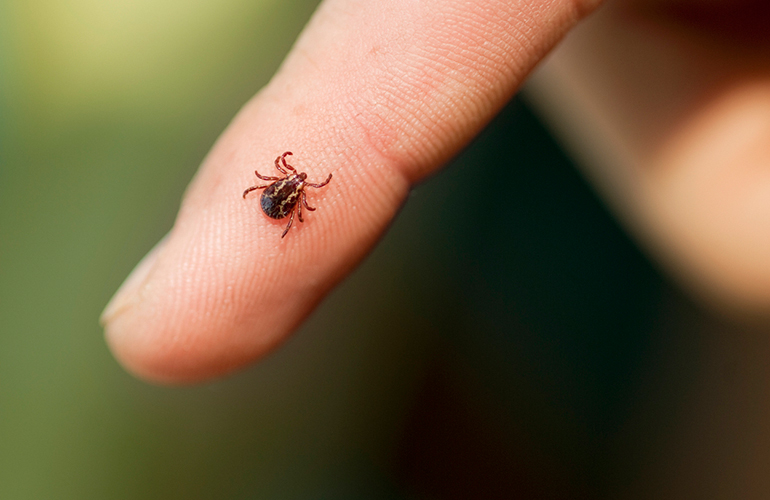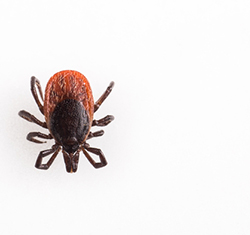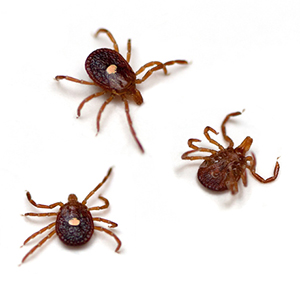

Deer Tick
Many scientists believe that 2017 will be a troublesome year for ticks in our area due to the mild winter weather. So it’s important to know what to do if you find a tick on your body because some ticks in our area can transmit dangerous diseases. The deer tick (also known as the black-legged tick) can carry Lyme disease. Other ticks, such as the Lone Star tick, can transmit Rocky Mountain spotted fever.

Lone Star Tick
You don’t have to go camping to get bitten by a tick, people are often bitten right in their own backyards. Remember that a tick bite is usually painless. That’s why it’s important to check yourself, your kids, and your pets for ticks each day, especially during the warmer months. Keep in mind that it takes about 24 – 36 hours for a tick to transmit pathogens into your bloodstream. So if you can find and remove a tick promptly, the transmission of disease can be prevented.
If you do find a tick attached to yourself, don’t panic, just follow the guidelines below:
- Find some tweezers. Carefully go under the head of the tick with the tweezers and pull the mouth of the tick away from your skin. Don’t squeeze the body of the tick which can increase the chance of pathogens getting into your bloodstream.
- After removing the tick, thoroughly clean the bite area and your hands with rubbing alcohol, an iodine scrub, or soap and water. If you wish, you can dispose of the tick by submersing it in alcohol or flushing it down the toilet.
- See if tick-borne diseases are present in your area. A good place to check is the website of your state’s health department, which can inform you if Lyme disease and other tick-borne diseases are being reported near you. You can rest easier if no disease was likely present when you were bitten.
- Look for a rash. It’s important to monitor your health if you think you have been bitten by a tick. It can take a few days or even weeks for symptoms to appear. Look for a rash that is red and expanding. (It doesn’t have to be the classic, bulls-eye rash associated with Lyme disease.) If you have an expanding rash, or other symptoms such as a headache, fever or flu-like symptoms, see a doctor immediately. Early treatment is very important to prevent more severe problems later on.
Learn more about how to prevent tick bites here.
21 Responses
Stay in touch with the conversation, subscribe to the RSS feed for comments on this post.
I always send any ticks that have been attached to me for more than a few hours to this lab. There is a cost. Prices are listed on the website.
Tick Report
Laboratory of Medical Zoology (LMZ)
Fernald Hall, University of Massachusetts
270 Stockbridge Rd, Amherst, MA 01003I think it’s very important to explain that there are people who don’t get a rash, but contract Lyme disease. I’ve gotten the impression that most people assume they don’t have Lyme because a rash never appeared — this is NOT a safe assumption!
I have read not to agitate the tick. To just grab it as close to the skin as possible and grasp the tickets and pull it out. I read that if you agitate the tickets it can regurgitate its stomach along with bacteria and toxins into the bloodstream.
Also I did not throw away the tick. I put it in a double baggie and sealed it and brought it to my son’s pediatrician so she could send it off to be tested for diseases. I also heard that you can bring it to the public health department and they will do testing. This way if it does have something they can know the area the tick came from.Yes, I agree with Eugenia…best to save the tick to show your doctor later in case symptoms develop, or you just want to have it checked to be sure it is not a lyme or other disease carrier, rather than throw it away. Also, flushing it is probably NOT a good idea anyway..
Then instructions in this article as to how to remove ta tick are not very clear, I thought.
Without grasping it firmly, how exactly is one supposed to remove it?
I have always seen instructions saying to “grasp it firmly with tweezers and pull straight up”.
Can you better explain the removal process, please??Try to grasp the tick as close to the head as you can with the tweezers. Then pull it upward slowly and consistently until it lets go. Try to do this without squeezing the body of the tick too hard. This is because you don’t want the blood inside the tick to reenter your bloodstream, which could increase the risk of infection.
What should people do after removing the tick to be sure that you have not been infected. How long does it take for the disease to show up on a lab test? Days, weeks, ….. If insurance doesn’t cover the test, how much does it cost?
The incubation period for Lyme disease is from 3-30 days. Other tick-borne diseases will be different. It can take several weeks for blood tests to accurately diagnose tick-borne illnesses. If you develop a rash or fever within several weeks of removing a tick, see your doctor. Be sure to tell the doctor about your recent tick bite, when the bite occurred, and where you most likely acquired the tick. Your medical provider and insurance company can provide more information on the costs of testing. You can learn more about testing for Lyme disease at this CDC website:
I’m so glad that Reliant is getting some information out about this disease that has blown to great proportions! I had been misdiagnosed for years so now it is chronic Lyme with all kinds of complications such as stroke, hearing loss, brain fog and several other symptoms that all come back to Lyme. Hopefully the Doctors at Reliant and be more educated with up to date information and not call us crazy! There is a wonderful group in Worcester called Central Mass. Lyme Foundation that helps people connect with others and information. There is going to be the third annual Lyme Conference right here in Worcester on” September 23, 2017″. It really would be good to get the word out to medical professionals to attend with lots of big name physicians that have treated and have information that would be helpful to all.
In the guidelines, I think it should say: notify your doctor in any case, not only if you find a rash. Also, instead of flushing it down the toilet, it would be wise to try to identify the tick and find out whether it has the parasite (if the resources are available). In MA, UMass Amherst has a lab that will identify the tick and study it for the presence of the disease causing organism.
Babesiosis shows no rash, has symptoms resembling malaria, and can be fatal. I spent 7 days in ICU having meds injected thru a PICC line and was out of my mind prior to the hospital stay. I had to call 911 and be transported to the hospital. Fortunately, the hospital had an infectious disease center with expert doctors so the disease was recognized immediately. Not a fun time.
Ticks can transmit several diseases other than Lyme and Rocky Mtn spotted fever. Stay out of tall grass and brushy areas.
Does everyone know what a pathogen is? Should define it or use another term.
I was diagnosed with babiesious. About 15 years ago . Doctors need to take it seriously! Been sick for years ! Finally a doctor noticed the test I had done and is treating me for Lyme. I only wish my doctor had treated me for this years ago! The test for Lyme sometimes turns out negative . Like mine did. There is a more accurate test from I gene X lab!
Another way to remove a tick, and get head and all intact…..put a tiny dab of liquid soap or hand sanitizer on cotton of qtip. Go in a circular motion with the qtip, around the tick, as close as possible to where the head of the tick and skin are connected, applying light pressure. It may take 20 to 25 circular motions around the tick but all of a sudden you will notice the tick withdrawing from the skin. The qtip motion sort of unscrews the tick from your skin. You get the tick out whole.
Sounds crazy but it really works.The picture of the deer tick is wrong. That is a wood tick. Please correct this!!
Also, there is research that shows the transmission of bacteria from tick to host in much less than 24-36 hours. And Powassan virus can be transferred in as little as 15 minutes.
Also, the frequency in which a rash appears (any rash, not just Bullseye rash) is somewhere in the mid-thirty percentile.
And to top it off, the ELISA test, which is the standard first tier test received at the doctor’s office, is woefully inaccurate and was designed early on as a surveillance test, not a diagnostic test.
The tick on the person’s finger is a brown dog tick.
You are correct, Susan! The other ticks mentioned in the article have been identified by name with example photos.
Good article, but incomplete. While you had the opportunity you could have
#1. identified what type tick is in photo at head of article, and
#2 as you mentioned two types of ticks , Deer & Lone Star, you could have shown an identifying photo of each.Thanks for the suggestion, Robert! We added some identifying photos of the ticks.
Excellent articles re: ticks & prostate
You did not mention that ticks in our area are also carrying Babesiosis. And it would be helpful to mention the symptoms of that and Rocky Mountain Spotted Fever.
MA insurance companies do not cover the cost of the DNA test that is necessary to verify a case of Lyme . Hundreds of people are misdiagnosed because of the flawed test that MA insurance companies do cover. Our daughter was tested three times with the flawed test and they all came up negative even though her doctor thought she had Lyme. Finally she went elsewhere and paid for the correct test which proved she did, in fact, have Lyme and she is paying the price of those flawed tests with many horrible problems and may have to quit her job because of it. She has been walking around (barely) for over two years with undiagnosed Lyme because of those flawed tests. Don’t let this happen to you.


